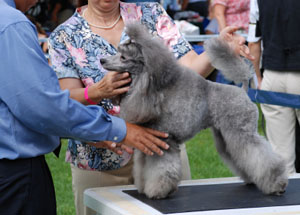Obedience
Using the LaGuard K9 Fitness Vest as a training aid assists in keeping dogs focused. Exercise before obedience training can create a calm and submissive state in your dog. LaGuard K9 Fitness Vests utilize resistance conditioning to decrease the time required to exercise your dog before and during obedience training sessions.
Show Dogs / Conformation

A show dog is not a variety, kind, type, or breed of dog; neither is it a dog trained for a specific skill, as in assistance dog or police dog; rather, a show dog refers to any dog entered into a dog show. Often used as a single word (showdog), the term may also refer to a dog in the sport of conformation that displays a particularly energetic or outgoing character. Entry into many sorts of dog shows is restricted to purebred dogs registered with the kennel club or breed club sponsoring the show.
Dog shows may be held indoors, in horse arenas or other suitably large spaces, or outdoors on groomed fields. Events at which dogs may be shown vary in the requirements for entry and the amount of preparation required. Types of dog shows include:
- Fun shows: Usually put on by charities for fund raising, these dog shows may offer prizes for costumes or for the largest and smallest dogs entered.
- Tests and Trials: Dog shows that display a dog’s training or natural instincts. They may require a great deal of formal training of the dog, as in obedience trials, or none at all, as in herding tests. Some are entertaining spectator dog sports, such as disc dog and dock jumping, and others are of more interest to the dog than to spectators, as in earthdog trials and hunt tests.
- Conformation shows: Originally devised for the selection of breeding stock, conformation showing has evolved into a sport requiring specific training for both the dog and handler, as well as precise grooming requirements (depending on the breed being shown.)
Popular Show/Conformation Dogs
- American Water Spaniels
- Barbets
- Bichon Frisés
- Poodles
Recommended Exercises
- Retrieving skills
- Jumping Skills
- Handler chase and focus activities
- Targeting skills
Additional Exercises:
Tunnel exercise: Make a tunnel or maze with some old cardboard boxes or chairs and encourage your dog to explore and go through it.
Concentration exercise: Hide some treats inside an old wash-glove or in a rolled up towel.
Brain exercise: Turnover a bowl and hide the treats under it. Doggie must use creativity to turn the bowl over and get treats.
Law Enforcement

The traditional patrol dog in America is a “find and bite” dog which finds suspects by tracking or searching and bites and holds them.
These dog teams form the bulk of law enforcement dogs today, but many have expanded their talents to include the location of evidence items as well as suspects.
Many law enforcement agencies, such as the FBI, SWAT teams to local fire departments, are cross training dogs to be detector dogs, similar to the dogs used by the Homeland Security in airports which locate drugs or other contraband. Cross training is an excellent use of resources, but not all dogs are capable of being trained for patrol work or make good detector dogs. Although this type of dog may seem to be nothing but a liability to some law enforcement agencies, it is the dog that prevents injuries to officers when apprehending a dangerous subject. The best control of liability is the wise choice of the dog, training program, and, most of all, a handler who will properly train and utilize the dog so that it does not become a liability. A police dog will only reflect the personality of the handler who trains him because the handler provides leadership for the dog. An aggressive, insecure handler will end up with an aggressive and volatile dog, and the confident, considerate officer will have a friendly and controllable dog.
Most law enforcement agencies do not like to train a dog that is younger than 10 months old. Even though a dog might start to show exceptional qualities and score high on a pretest, the lack of concentration of younger dogs is hard for handlers to manage. By the same token, agencies do not like to start training a dog that is older than 2 1/2 years. There are exceptions if a dog has had prior training, or is truly exceptional.
Popular Law Enforcement Breeds
- Many departments employ dogs which specialize in scent work such as tracking, so Bloodhounds set the standard as tracking dogs.
- There is also reduced liability with the lack of protection training, and breeds such as Labrador Retrievers, which are perceived by the public to be less threatening.
- German and Dutch Shepherds
- Dutch and Belgian Malinois
- Rottweilers
- Doberman Pinscher
- American Pit-bulls, Golden Retrievers and Labradors are not seen often, but are excellent for narcotics, bomb, cadaver and accelerant work. They should not be overlooked for that type of specialty.


